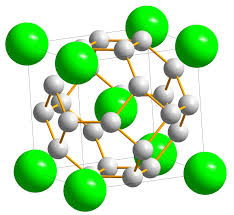 |
Facts
Duration: 1 semester
Period: Fall (2) Semester
Credits: 2 ECTS
Contact Hours: 50
Self-study: 22
Hours: 72
|
Main Objectives
- to give theoretical knowledge about physical and chemical aspects of surface science methods;
- to give knowledge about characterization methods essential to study the physical-chemical properties of solid materials (size, morphology, dispersion on the sup-port, atomic structure, chemical composition, oxidation state, poisoning, etc.)
- getting knowledge about surfaces properties (surface atomic reconstructions, faceting, chemical composition, adsorbed species, adsorption sites, oxidation state, organization and characteristics of nanoparticles on surfaces).
- profound theoretical development of the basic representations about features of materials;
- forming knowledge about opportunities to use modern surface science methods to investigate features of structure and chemical state of different materials.
Learning Outcomes
Formation of competence:
а) intercultural:
- know the basic concepts of English language in the Principles of physics and application of surface science; physical principles, advantages and disadvantages of surface science methods considered during the course; application of the results ob-tained by the methods;
- be able to explain the data obtained with surface science methods, use the da-ta, apply skills and knowledge in unassisted writing of articles, abstracts; apply the basic concepts of surface science methods to explain theoretical material and analyz-ing the experimental data;
b) professional:
- have skills: working with the calculated formulas to solve computational problems regarding the details of the surface structures of materials; modeling and prediction of catalyst properties and catalytic processes; reviewing scientific and me-thodical literature.
Professor
Francisco Cadete Santos Aires
Course annotation
|
Course unit code |
Specialization04.04.01 – Chemistry |
|||||
|
Course unit title |
Modern surface science methods to study structure and elemental composition of solids |
|||||
|
Name(s), surname(s) and title of lecturer(s) |
Prof. Francisco Cadete Santos Aires |
|||||
|
Level of course |
Master |
|||||
|
Semester |
3 |
|||||
|
ECTS credits |
2 |
|||||
|
Working hours |
Contact hours |
50 |
||||
|
lectures |
28 |
|||||
|
seminars |
22 |
|||||
|
practical classes |
||||||
|
laboratory classes |
||||||
|
consultations |
||||||
|
Independent work |
22 |
|||||
|
Total |
72 |
|||||
|
Work placement |
none |
|||||
|
Language of instruction |
English |
|||||
|
Prerequisites |
Chemistry, Physics |
|||||
|
Objectives of the course |
Learning outcomes |
A student’s assessments methods |
||||
|
aims: -to give theoretical knowledge about physical and chemical aspects of surface science methods; -to give knowledge about characterization methods essential to study the physical-chemical properties of solid materials (size, morphology, dispersion on the sup-port, atomic structure, chemical composition, oxidation state, poisoning, etc.) -getting knowledge about surfaces properties (surface atomic reconstructions, faceting, chemical composition, adsorbed species, adsorption sites, oxidation state, organization and characteristics of nanoparticles on surfaces). -profound theoretical development of the basic representations about features of materials; -forming knowledge about opportunities to use modern surface science methods to investigate features of structure and chemical state of different materials. |
Formation of competence: а)intercultural: -know the basic concepts of English language in the Principles of physics and application of surface science; physical principles, advantages and disadvantages of surface science methods considered during the course; application of the results ob-tained by the methods; -be able to explain the data obtained with surface science methods, use the da-ta, apply skills and knowledge in unassisted writing of articles, abstracts; apply the basic concepts of surface science methods to explain theoretical material and analyz-ing the experimental data; b) professional: -have skills: working with the calculated formulas to solve computational problems regarding the details of the surface structures of materials; modeling and prediction of catalyst properties and catalytic processes; reviewing scientific and me-thodical literature. |
Presentations, tests and written exam. |
||||
|
Teaching methods |
Lectures, groupwork, delivery of individual presentations, independent study of literature, casestudies, roleplays, brainstorming. |
|||||
|
Course unit content |
Title |
Lecturers (hours) |
Self-study (hours) |
|||
|
General Introduction |
8 |
4 |
||||
|
Surface structure. Surface crystallog-raphy. Thermody-namics. Adsorption |
10 |
4 |
||||
|
Reciprocal space methods. LEED. SXRD. GISAXS |
10 |
4 |
||||
|
Direct space meth-ods. General intro-duction. STM. AFM. |
10 |
4 |
||||
|
Spectroscopies. XPS. AES. LEIS. Vibration spectros-copies |
10 |
4 |
||||
|
Defense of the presentations |
2 |
|||||
|
Tests |
2 |
|||||
|
50 |
22 |
|||||
|
Assessment requirements |
Student’s skills in this subject will be evaluated by means of presentations in the seminars, written tests and final examination. |
|||||
|
Assessment criteria |
The assessment of the presented works is carried out by the following criteria: – compliance of the contents to a subject; – existence of logical communication of stated information; – compliance of registration to requirements; – work is handed over in time. |
|||||
|
The composition of final accumulative mark |
Final accumulative mark consists of: 3 tests – 10 %, group presentation of individual work – 20 %, exam – 50 % |
|||||
|
Course outline arranged by |
||||||
.png)